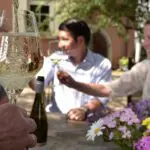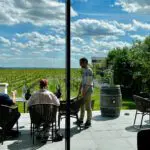
Quantities
Following a small harvest in 2019, this year’s crop is again slightly down. In Franconia, Saxony and Saale-Unstrut in particular, late frosts have led to crop losses. However, average quantities of grapes could be harvested in the Palatinate and Rheinhessen.
Vegetation and harvest
After the dry winter of the previous year, heavy rainfall in January and February 2020 replenished some of the water reserves. A very warm and sunny spring led to an early budding, and equally early flowering accordingly. In warm locations early grape varieties, started flowering end of May already. With that an early harvest was anticipated, given the average duration of 100 days from flowering to ripening of the grapes.
The summer’s drought meant that the grapes remained rather small-berried. September came in sunny, warm and dry, prompting maturity of a number of grape varietals at the same time. Initially blessed with cool days, the harvesting teams had to avoid heat and sunshine by working in early morning hours or even at night.
Statements from vintners in the 13 German wine regions:
Ahr Valley – Earliest Harvest Ever – according to Marc Adeneuer of Winery J.J. Adeneuer
“It was the earliest harvest ever. We had already harvested all the grapes at the end of September. 30 years ago that would have been unthinkable. We were able to harvest a small amount of very good quality. By consistent crop thinning, we were able to achieve very loose grapes and yield beautiful colors for the red wines.”
BADEN – Healthy berries, fresh, fruity young wines – according to Joachim Heger, Weingut Dr. Heger:
“In the last frosty nights of the year there was minor damage in the northern areas of Baden and the trickled bloom reduced expectations of the harvest yield. The harvest of healthy berries could already begin at the beginning of August. As in previous years, the harvest was very quick in order not to miss the optimal harvest times for the different varieties and different plots and to avoid overripe. After weeks of intense work, the first winemaker was able to conclude harvest on September 11th and many colleagues finished soon in the weeks thereafter, especially at the Kaiserstuhl or in Breisgau. The last grapes were harvested in the higher elevations of the Black Forest (e.g. in Ortenau) but also around Lake Constance at the beginning of October. The first young wines are still very fresh with a lot of fruitiness and a high potential. “
FRANKEN – quality good, yet a third of the normal harvest – Melanie Stumpf, Winery Bickel-Stumpf:
“The yield in Franconia this year was much smaller than in previous years. This was due to a massive late frost at the beginning of May, which hit the vintners on the Mainschleife and in the Steigerwald particularly hard. In some cases, only a third of the normal harvest was brought in. In areas where the grapes survived the frost, a dry summer worked well with the vegetation, resulting in tasty and healthy grapes. Extensive rain in August provided a finally boost to quality and the harvest could begin early September. […]. “
MITTELRHEIN – beautiful aromas and integrated acidity, according to Jochen Ratzeberger, Winery Ratzenberger:
“Fresh fruit and optimal acidity shaped the grape harvest at the Middle Rhine. We were able to pick healthy, golden yellow grapes and the musts show beautiful aromas and a wonderfully integrated acidity. “
MOSEL – Classic, light Riesling wines with fresh acidity, according to Dr. Carl von Schubert, VDP.Weingut Maximin Grünhaus:
“The Moselle and its tributaries have a large number of terroirs and special climatic niches, so that the reports of our VDP colleagues do diverge. Almost all colleagues, however, report that the 2020 vintage brought classic Riesling wines with fresh acidity and moderate alcohol content. Vintage 2016 is often mentioned for comparison, which shone with elegant, light wines that were very enjoyable to drink from an early stage. Overall, people are pleased with grape quality and quantity. “
Wineregion NAHE – Noble sweet wines in homeopathic amounts, reports Frank Schönleber, Winery Emrich-Schönleber:
“The grape harvest began on the Nahe in mid-September, starting with the pinot grape varieties, all of which could be harvested in excellent health and maturity. At the beginning of October, the Riesling harvest followed, with perfectly healthy, golden yellow grapes that are very aromatic and harmonious in taste. Noble sweet wines from 2020 on the Nahe will only be available smallest amounts. “
Wineregion PFALZ – Very distinctive varietal and location characteristics – according to Hansjörg Rebholz, Winery Ökonomierat Rebholz:
“The ideal weather conditions throughout the year ensured that harvesting began very early in the last days of August. The extremely hot temperatures in mid-September forced us to start harvesting very early in the morning for a week so, such as to prevent the grapes from getting too warm, and also to protect our pickers from the sun and heat. We are very satisfied with the result of the harvest. Not only because we were able to harvest exceptionally healthy and ripe grapes, but also because this was possible despite the currently quite complex health and safety conditions. We expect wines from the 2020 vintage to show very clear, very distinctive varietal and location characteristics, as well as a pleasant acidity. “
Wineregion RHEINGAU – Second earliest harvest since weather records – as seen by Wilhelm Weil of winery Robert Weil:
“In the Rheingau we scored the earliest harvest ever – with exception of after 2014. Thanks to a sunny and dry late summer, very ripe and healthy grapes could be harvested. The first white wines in the barrel are accordingly aromatic and extremely fruity, the red wines show a lot of color and great potential. In many estates, the grape harvest was completed after three to four weeks already. “
Wineregion RHEINHESSEN – tense harvest weeks with perfectly healthy grapes – Johannes Hasselbach, Winery Gunderloch reports:
“It was definitely a very special harvest. Due to the accompanying circumstances, it was for a long time uncertain whether the harvest workers could come and how we could apply the hygiene rules in a consistent and practical way. But with the start of the harvest our worries vanished. One almost had the feeling that nature wanted to do something good again and compensate us for the challenges:
We harvested mostly healthy grapes over six very intensive weeks. The aroma developed consistently over this time, while the acid values remained pleasantly stable. At ours the harvest began on September 3rd, and until the end of September we didn’t have a single rainy day. The rain that set in then brought urgently needed rest days for the harvest team as well as an exciting aromatic further development of the grapes. Since over 90% of the harvest was complete, the onset of botrytis didn’t bother us in the least. Rather, it made it possible for us to produce excellent wines from this vintage – including Trockenbeerenauslese. The quantities harvested are within the normal range.
One can already say that this is a vintage that will be remembered for a long time by both the winemaker and wine lovers. “
Wineregion SACHSEN / SAALE-UNSTRUT – 20% less yield due to late frosts – says Georg Prinz zur Lippe, Winery Proschwitz Castle:
“The fateful day of the year was May 12th. In Saxony, there was precipitation during the day and wind chills of two to three degrees below zero followed at night. The 10-15 cm long shoot tips froze on the wet, not dried vines. The frost-damaged vines recovered to some extend, but in Saxony the yield is greatly reduced. On average, the quantities fell short by 20% compared to the past year.
In the Saale-Unstrut wine growing area, the late frost on the night of May 12th went down to -6 ° C and had very serious consequences for some winegrowers in the growing area. The vines recovered from the frost, but in some cases up to 80% loss of yield was recorded..
The weather conditions of the 2020 wine year resulted in a very diverse maturity development of the berries. Highly selective harvests were necessary in order to be able to achieve batches of similar maturity. “
Wineregion WÜRTTEMBERG – The early and late grape varieties ripen closely together – according to Markus Drautz, Winery Drautz-Abele:
“That was my 15th vintage in charge of our winery and I had to realize one thing again: no two grapes are the same and every year there are different challenges. It felt like one of the fastest harvests ever. This was due to the small quantities harvested, the very healthy grapes and the close proximity in maturity of the early and late ripening varietals. The yields are about 20% below average due to the drought. The quality is well above average, the musts are very tasty and often also have a pleasant, appropriate acidity. “
Source: @VDP








